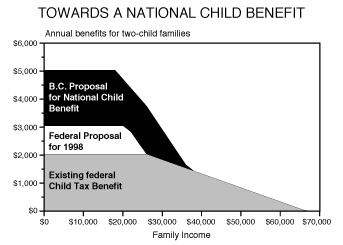G. Topic Box:
NATIONAL CHILD BENEFIT
The provincial and federal governments have been working towards developing a National Child Benefit for Canada. When it is fully implemented it will represent one of Canada's most important social policy initiatives. Its main significance lies in the fact that it applies children's benefits to all low and modest income Canadians equally, regardless of whether the main source of family income is earnings or social transfers from government. In so doing it can fulfil the objectives set out by First Ministers for a National Child Benefit: help prevent and reduce child poverty; promote participation in the workforce, resulting in fewer families having to rely on social assistance; and, reduce overlap and duplication.
British Columbia is the lead province advancing this initiative at the national level. This lead reflects British Columbia's experience in implementing its own benefit, the BC Family Bonus, which provides a practical model upon which to base the National Child Benefit.
How the BC Family Bonus Works
Introduced in July 1996, the BC Family Bonus replaces income assistance payments for children with an income-tested benefit. This benefit equally serves all British Columbia families with low and modest incomes -- both working and income assistance families with children.
The BC Family Bonus is delivered through the income tax system in the form of monthly cheques. The maximum annual benefit is $1,236 per child under the age of 18; this is equivalent to the amount previously provided through the income assistance system for the basic needs (excluding shelter) of children.
The maximum benefit amount is paid to a family with a net income of $18,000 or less. The benefit level is decreased gradually as income rises above the $18,000 threshold, reaching zero at different levels of family income, depending on the size of the family. For example, a family with three children receives benefits up to an income level of $41,175, while a family with two children receives benefits up to an income level of $33,450.
The first outside evaluation of the BC Family Bonus reveals that it has reduced the poverty gap for British Columbia's low and modest income families by an estimated 19 per cent. In addition, since the BC Family Bonus was introduced, the number of dependent children on income assistance has decreased by about 4,000 each month as families move from income assistance to work. This result demonstrates the positive effect of removing a major financial barrier to those considering employment or training. By ensuring that child benefits will continue with employment instead of being cut off, as is the case under most income assistance systems, the BC Family Bonus reduces the financial penalties facing income assistance recipients who find work.
The Basic Plan for a National Child Benefit
The basic intent of a National Child Benefit would be to replace the current mix of federal and provincial income support programs for children (primarily the federal Child Tax Benefit and provincial income assistance in respect of children) with an integrated system providing similar benefits in respect of all low and modest income children.
The ultimate goal would be to have a National Child Benefit of sufficient size to replace all child-related income assistance benefits to families in all provinces, as has already been achieved in British Columbia through the BC Family Bonus. A sufficient amount of federal funding for a National Child Benefit would allow provinces to reallocate funds currently spent on income assistance to other programs assisting children in low to modest income families.
British Columbia's Proposal for a National Child Benefit
British Columbia has urged that the federal government and the provinces provide a benefit level sufficient to take all Canadian children off income assistance by the year 2000. In order to achieve a high enough benefit level, provinces would help to cover the costs of the program.
Particular features of the proposed benefit include the following:
- The maximum benefit level, to be achieved by the year 2000, would be $1,500 per child per year (in addition to the amount currently provided by the federal Child Tax Benefit).
- The benefit would be phased in over a three-year period.
- The federal government would provide about 75 per cent of the funding and the provinces the remaining 25 per cent. The provincial share of costs would be offset by the savings realized as the new benefit replaces income assistance payments in respect of children.
- Any additional income assistance savings to provinces would be directed at programs for low and modest income families with children.
Federal Response: The Canada Child Tax Benefit
In its 1997 budget, the federal government announced its intention to introduce a new federal benefit, to be called the Canada Child Tax Benefit. In this proposal, the existing Child Tax Benefit would be increased for all "low income" families by up to:
- $605 annually for the first child;
- $405 for the second child; and,
- $330 for each subsequent child in a family.
The federal intention is that the Canada Child Tax Benefit be implemented in July 1998. As an "interim step" for 1997, those persons currently receiving the federal Working Income Supplement (a benefit paid to low income families with earned income) will have their benefits changed to reflect 1998 Canada Child Tax Benefit amounts.
The federal proposal for 1998 does not constitute a mature and adequate National Child Benefit. Rather it is what the federal government calls a "down payment". Figure 1 contrasts, for a family of two children, the benefits from the federal plan with the benefits British Columbia's proposal would provide.
